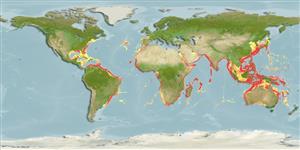Environment: milieu / climate zone / depth range / distribution range
Ekologi
marina; brackvatten revassocierade; havsvandrande (Ref. 51243); djupintervall 0 - 1200 m (Ref. 9739). Subtropical; 17°C - 32°C (Ref. 12459); 47°N - 37°S, 98°W - 166°E (Ref. 12459)
Worldwide in tropical and subtropical waters, but absent in the eastern Pacific (Ref. 9739, 33390) and the Pacific Plate, except marginally (Ref. 10948). Western Atlantic: Canada (Ref. 5951) to Bermuda and Massachusetts, USA to Argentina (Ref. 7251), including the Gulf of Mexico (Ref. 9626) and entire Caribbean (Ref. 26938). Eastern Atlantic: Morocco to South Africa. Indo-West Pacific: East Africa (Ref. 2871, 5213, 6644, 30573) and Hokkaido, Japan to Australia.
Length at first maturity / Size / Vikt / Age
Maturity: Lm ?, range 43 - ? cm
Max length : 200 cm TL hane/ej könsbestämd; (Ref. 10790); common length : 110 cm TL hane/ej könsbestämd; (Ref. 3487); publicerad maxvikt: 68.0 kg (Ref. 7251); rapporterad maxålder: 15 år (Ref. 9739)
Short description
Bestämningsnycklar | Morfologi | Morfometri
Taggstrålar i ryggfenan (totalt) : 7 - 9; Mjukstrålar i ryggfenan (totalt) : 26 - 33; Taggstrålar i analfenan: 2 - 3; Mjukstrålar i analfenan: 22 - 28. This species is distinguished by the following characters: head broad and depressed; first dorsal fin usually with VIII short but strong isolated spines, not connected by a membrane; caudal fin lunate to emarginate in adults, upper lobe longer than lower, rounded in young with prolonged central rays. Colour of back and sides dark brown, with 2 sharply defined narrow silvery bands, belly yellowish (Ref. 10948, 90102).
Adults occur in a variety of habitats, over mud, sand and gravel bottoms; over coral reefs, off rocky shores (Ref. 10948) and in mangrove sloughs; inshore around pilings and buoys, and offshore around drifting and stationary objects; occasionally in estuaries (Ref. 9739). Form small groups and may pursue small pelagic inshore (Ref. 48635). Feed on crabs, fishes, and squids (Ref. 5213, 10948, 13442). Form spawning aggregations during the warm months in the western Atlantic; eggs and larvae planktonic (Ref. 12459). Caught in small quantities due to its solitary behavior (Ref. 9626). Caught mainly with handlines, and by trolling pelagically offshore over the continental shelf (Ref. 10948). Good food fish; marketed fresh (Ref. 5284), smoked, and frozen (Ref. 9987). Also caught for sport (Ref. 26938).
Form spawning aggregations during the warm months in the western Atlantic; eggs and larvae planktonic (Ref. 12459).
Shaffer, R.V. and E.L. Nakamura, 1989. Synopsis of biological data on the cobia Rachycentron canadum (Pisces: Rachycentridae). NOAA Tech. Rep. NMFS 82, FAO Fisheries Synopsis 153. (Ref. 9739)
IUCN Red List Status (Ref. 130435: Version 2024-1)
Threat to humans
Harmless
Human uses
Fiskeri: mindre kommeriell; Vattenbruk: kommersiell; sportfisk: ja
Verktyg
Special reports
Download XML
Internet-källor
Estimates based on models
Preferred temperature (Ref.
123201): 8.1 - 19.8, mean 12.9 °C (based on 1010 cells).
Phylogenetic diversity index (Ref.
82804): PD
50 = 1.5000 [Uniqueness, from 0.5 = low to 2.0 = high].
Bayesian length-weight: a=0.00490 (0.00359 - 0.00668), b=3.11 (3.02 - 3.20), in cm total length, based on LWR estimates for this species (Ref.
93245).
Trofisk nivå (Ref.
69278): 4.0 ±0.0 se; based on diet studies.
Generation time: 3.9 (2.2 - 4.6) years. Estimated as median ln(3)/K based on 16
growth studies.
Resiliens (Ref.
120179): Mellan, lägsta populationsfördubblingstid 1,4-4,4 år (K=0.09-0.22; tm=2-3; tmax=15).
Prior r = 0.58, 95% CL = 0.38 - 0.87, Based on 2 full stock assessments.
Fishing Vulnerability (Ref.
59153): Moderate vulnerability (42 of 100).
Climate Vulnerability (Ref.
125649): High vulnerability (62 of 100).
Nutrients (Ref.
124155): Calcium = 13.7 [6.0, 25.4] mg/100g; Iron = 0.49 [0.24, 0.88] mg/100g; Protein = 20 [19, 21] %; Omega3 = 0.167 [0.084, 0.369] g/100g; Selenium = 47.6 [20.3, 101.5] μg/100g; VitaminA = 18 [5, 73] μg/100g; Zinc = 0.435 [0.271, 0.692] mg/100g (wet weight); based on
nutrient studies.
